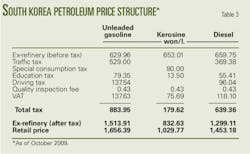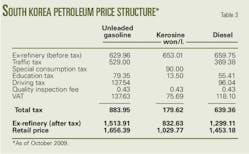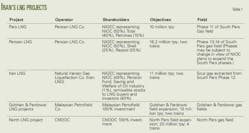Plutonio is a low-sulfur, medium-gravity crude oil from Angola's deepwater Block 18. Greater Plutonio consists of five oil fields from water depths of around 1,300 m: Plutonio, Galio, Paladio, Cromio, and Cobalto, all of which lie within 20 km of each other and whose production forms the Plutonio crude blend. Samples have shown these five fields to be very similar in quality, says BP PLC.
Production began in September 2007 (OGJ, Oct. 8, 2007, p. 8) and quickly reached more than 200,000 b/d. The assay given here is from a sample dated Mar. 18, 2008.
According to BP, the Angolan deep water has seen considerable exploration success in Blocks 15, 17, and 18, where BP is operator. BP also operates the ultradeep water Block 31, which by yearend 2009 had yielded 13 exploration successes.
Greater Plutonio is being developed and operated by BP with a 50% equity interest. The remainder is owned by Sonangol Sinopec International Ltd, the joint venture between China Petroleum & Chemical Corp. (Sinopec) and Sonangol, Angola's national oil company.
Oil produced on Plutonio is exported via a dedicated floating production, storage, and offloading (FPSO) vessel, loading through its own remote offloading buoy close to the production platform. The FPSO (photo) has storage capacity of 1.74 million bbl, processing capacity of 240,000 b/d of oil, and gas handling of as much as 400 MMscfd (OGJ Online, Oct. 2, 2007). The vessel has a treated-water injection rate of 450,000 b/d.
According to BP, crude export parcel sizes are 1 million bbl. The buoy can accept either SuezMax or VLCC (very large crude carrier) vessels for "combi-cargoes," both as first or second cargo loads. With peak production in excess of 200,000 b/d, a cargo is available about every 5 days.
BP made its first discovery on the block in 1999-2001 in 1,200-1,450 m of water. The area's final development plan called for 43 wells—20 producers, 20 water injectors, and 3 gas injectors.
The subsea system includes the longest single riser tower of its kind in the world, BP said in 2007. At 1,258 m, it connects the FPSO to a network of subsea flow line and control systems that include 150 km of flow lines, nine manifolds, and 110 km of instrument and control umbilicals.
Whole crude*
API gravity at 60/60° F.: 33.2
Density at 15° C., kg/l.: 0.8585
Total sulfur, wt %: 0.36
Mercaptan sulfur, wt %: 0.0001
H2S, ppm (wt): <5*
Vis. at 20° C., cst: 14.5
Vis. at 30° C., cst: 10.5
Vis. at 40° C., cst: 7.95
Vis. at 50° C., cst: 6.18
Vis. at 60° C., cst: 4.93
Vis. at 100° C., cst: 2.4
Pour point, °C.: 6
Wax, wt %: 10.0
Total nitrogen, ppm (wt): 2,020
Basic nitrogen, ppm (wt): 707
Acidity, mg KOH/g: 0.151
Carbon residue, wt %: 3.52
Asphaltenes, wt %: 0.328
Vanadium, ppm (wt): 5.9
Nickel, ppm (wt): 20.9
Iron, ppm (wt): 3.2
Mercury, ppb (wt): <1
C2 & lighter, wt %: 0.02
C3, wt %: 0.31
i-C4, wt %: 0.23
n-C4, wt %: 0.85
i-C5, wt %: 0.72
n-C5, wt %: 0.91
C5 to 95° C.
Yield on crude, wt %: 6.37
Yield on crude, vol %: 7.94
Density at 15° C., kg/l.: 0.6870
Mercaptan sulfur, wt %: 0.0001
Total nitrogen, ppm (wt): 0.01
Acidity, mg KOH/g: 0.0722
Research octane no.: 67.8
Paraffins, wt %: 66.6
n-Paraffins, wt %: 26.6
Naphthenes, wt %: 32.1
Aromatics, vol %: 1.4
95-175° C.
Yield on crude, wt %: 11.932
Yield on crude, vol %: 13.42
Density at 15° C., kg/l.: 0.7603
Sulfur, wt %: 0.006
Mercaptan sulfur, ppm: 0.0002
Total nitrogen, ppm (wt): 0.69
Acidity, mg KOH/g: 0.0787
Research octane no.: 51.7
Paraffins, wt %: 45.1
n-Paraffins, wt %: 19.8
Naphthenes, wt %: 44.1
Aromatics, vol %: 10.8
C5 to 149° C.
Yield on crude, wt %: 14.349
Yield on crude, vol %: 17.01
Density at 15° C., kg/l.: 0.7214
Sulfur, wt %: 0.001
Mercaptan sulfur, wt %: 0.0001
Total nitrogen, ppm (wt): 0.11
Acidity, mg KOH/g: 0.0757
Research octane no.: 61.8
Paraffins, wt %: 55.1
n-Paraffins, wt %: 23.1
Naphthenes, wt %: 55.1
Aromatics, vol %: 5.5
149-232° C.
Yield on crude, wt %: 12.377
Yield on crude, vol %: 13.29
Density at 15° C., kg/l.: 0.7964
Sulfur, wt %: 0.029
Mercaptan sulfur, wt %: 0.0002
Vis. at 40° C., cst: 1.14
Vis. at 60° C., cst: 0.89
Total nitrogen, ppm (wt): 5.01
Acidity, mg KOH/g: 0.0858
Smoke point, mm: 26
Freezing point, °C.: –59
Cetane index (ASTM D4737-90): 42.7
Refractive index at 70 °C.: 1.4191
Naphthalenes, vol %: 0.8
Aromatics, vol %: 14.69
232-342° C.
Yield on crude, wt %: 19.131
Yield on crude, vol %: 19.48
Density at 15° C., kg/l.: 0.8401
Sulfur, wt %: 0.158
Mercaptan sulfur, wt %: 0.0001
Vis. at 50° C., cst: 2.81
Vis. at 100° C., cst: 1.32
Cloud point, °C.: –12
Pour point, °C.: –13
Wax, wt %: 6.1
Total nitrogen, ppm (wt): 72.0
Basic nitrogen, ppm (wt): 28
Acidity, mg KOH/g: 0.131
Smoke point, mm: 20
Freezing point, °C.: –9
Cetane index (ASTM D4737-90): 56.9
Refractive index at 70 °C.: 1.4465
Naphthalenes, vol %: 6.5
Aromatics, vol %: 20.45
Aromatics, wt %: 23.2
342-369° C.
Yield on crude, wt %: 4.344
Yield on crude, vol %: 4.26
Density at 15° C., kg/l.: 0.8729
Sulfur, wt %: 0.358
Vis. at 50° C., cst: 7.16
Vis. at 100° C., cst: 2.52
Cloud point, °C.: 15.0
Pour point, °C.: 15.0
Wax, wt %: 20.6
Total nitrogen, ppm (wt): 423
Basic nitrogen, ppm (wt): 122
Acidity, mg KOH/g: 0.16
Aniline point, °C.: 81.4
Cetane index (ASTM D4737-90): 63.9
Refractive index at 70 °C.: 1.4637
369-509° C.
Yield on crude, wt %: 21.895
Yield on crude, vol %: 20.8
Density at 15° C., kg/l.: 0.9005
Sulfur, wt %: 0.430
Vis. at 60° C., cst: 19.7
Vis. at 100° C., cst: 6.37
Pour point, °C.: 38.0
Wax, wt %: 20.0
Total nitrogen, ppm (wt): 1,340
Basic nitrogen, wt %: 428
Acidity, mg KOH/g: 0.129
Carbon residue, wt %: 0.0093
Asphaltenes, wt %: 0.0021
Aniline point, °C.: 91.0
Refractive index at 70 °C.: 1.4801
509-550° C.
Yield on crude, wt %: 5.229
Yield on crude, vol %: 4.82
Density at 15° C., kg/l.: 0.9279
Sulfur, wt %: 0.616
Vis. at 60° C., cst: 105.0
Vis. at 100° C., cst: 20.6
Wax, wt %: 20.0
Total nitrogen, ppm (wt): 2,950
Basic nitrogen, ppm (wt): 962
Acidity, mg KOH/g: 0.154
Carbon residue, wt %: 0.803
Asphaltenes, wt %: 0.0366
Aniline point, °C.: 98.5
Refractive index at 70 °C.: 1.4988
550-585° C.
Yield on crude, wt %: 3.427
Yield on crude, vol %: 3.11
Density at 15° C., kg/l.: 0.9413
Sulfur, wt %: 0.721
Vis. at 60° C., cst: 240.0
Vis. at 100° C., cst: 36.8
Wax, wt %: 20.1
Total nitrogen, ppm (wt): 3,830
Basic nitrogen, ppm (wt): 1,300
Acidity, mg KOH/g: 0.143
Carbon residue, wt %: 2.65
Asphaltenes, wt %: 0.12
Aniline point, °C.: 100.5
*Dissolved in liquid.More Oil & Gas Journal Current Issue Articles
More Oil & Gas Journal Archives Issue Articles
View Oil and Gas Articles on PennEnergy.com




